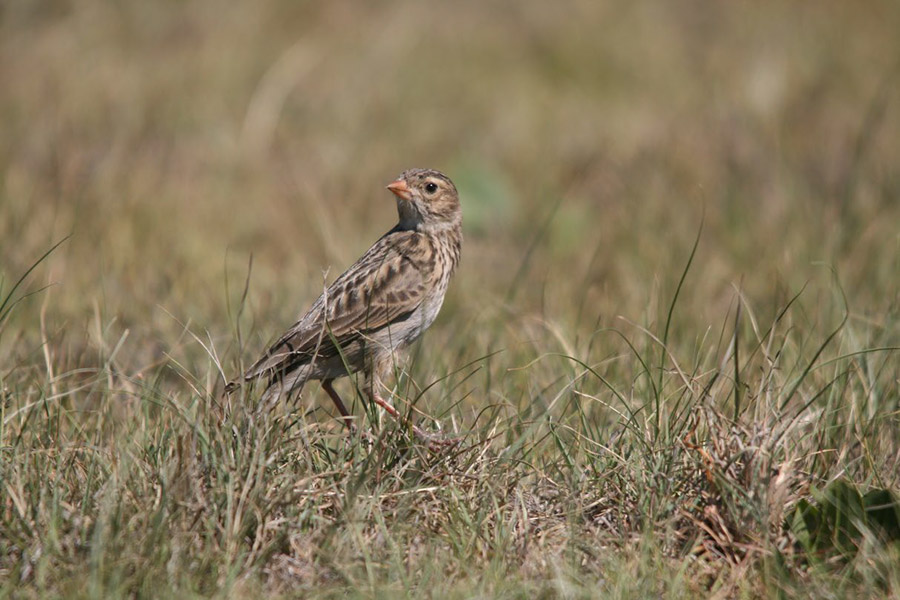Text and photographs by Matthew Orolowitz. Posted 03 February 2025.
Deep in the rolling grasslands of South Africa, an unusual sight caught the attention of researchers: a Botha’s Lark trailing closely behind a Rudd’s Lark. For several minutes, the diminutive Botha’s Lark followed the Rudd’s Lark—a bird of similar size but from a different genus—through the undulating veld. This seemingly innocuous behavior may hold a deeper, sobering story about the challenges facing these grassland birds.

The Botha’s Lark, South Africa’s most threatened endemic bird species, faces a high probability of extinction without urgent conservation efforts.
Botha’s Lark and Rudd’s Lark are two of South Africa’s most threatened endemic species. Both species rely on the Highveld’s pristine grasslands for survival—habitats that are rapidly shrinking due to agricultural expansion and changing agricultural practices, mining, and development. Despite sharing overlapping ranges, the two species typically keep to themselves, each with unique behaviors and breeding strategies – essentially occupying their own niches. The challenges faced by Botha’s Larks are compounded by their specialized needs. Unlike generalist species that adapt to a range of environments, Botha’s Lark requires specific grassland conditions—open, short-grass areas with minimal disturbance. When these conditions vanish, the birds are left with few options.
In this fascinating series of observations, wherever the Rudd’s Lark moved, the Botha’s Lark followed. This behavior was not observed just once but repeatedly throughout the breeding season. The Botha’s Lark would often display and closely trail the Rudd’s Lark, raising questions about its motivations and the implications for its survival. So why was the Botha’s Lark shadowing the Rudd’s Lark? It could reflect the population decline these birds face in the wild.
Botha’s Larks are notoriously scarce, and their numbers are alarmingly low. Recent surveys suggest that the number of birds has dwindled to just 340 individuals, making it increasingly difficult to find mates. As the species’ suitable habitat and niche availability shrinks, it is likely to come into contact more often with another, closely related species, as it struggles to adapt to the loss of prime habitat. In such a scenario, hybridization between rare species has been documented in other parts of the world, and it is possible that a lonely Botha’s Lark might be forced to attempt selecting a Rudd’s Lark for a potential partner—a poignant indication of the scarcity of suitable mates. The offspring of hybridization – the interbreeding of two separate species – is rarely viable.
This observation of the Botha’s Lark following and engaging in courtship displaying behavior to a Rudd’s Lark is a potential indication of an attempted inter-breeding event and a reminder of the intricate interconnections within ecosystems and how human activities can disrupt them. It also underscores the importance of conserving and restoring grasslands to support these vulnerable species.
While the sight of a Botha’s Lark attempting courtship with a Rudd’s Lark may evoke concern, it also serves as a call to action. Protecting their habitats can ensure these birds have the space and resources they need to thrive. Healthy grasslands are more than just a haven for birds; they play a crucial role in ecosystem functioning. These ecosystems provide essential services such as carbon storage, water filtration, nutrient cycling promoting soil health, and seed dispersal and pollination services, which directly benefit human livelihoods. When grasslands thrive, they support biodiversity and sustain the communities that rely on them for grazing, farming, and natural resources.
Efforts are underway to protect South Africa’s grassland birds, with stewardship programs that encourage sustainable land use, and through scientific research that sheds light on the needs of species like Botha’s Lark. However, these efforts require collaboration between landowners, conservationists, and policymakers.
Critical to these conservation efforts is the support of Birding Ecotours, which has funded the research and conservation action required to address many of these challenges. This funding has made it possible to establish dedicated research positions, enabling us to monitor and study these species more effectively. By investing in science and conservation, Birding Ecotours has provided a foundation to develop long-term solutions to the challenges faced by Botha’s Lark.
The story of these two larks is more than just an oddity of nature. It symbolizes the urgent need to safeguard South Africa’s unique biodiversity for future generations.
